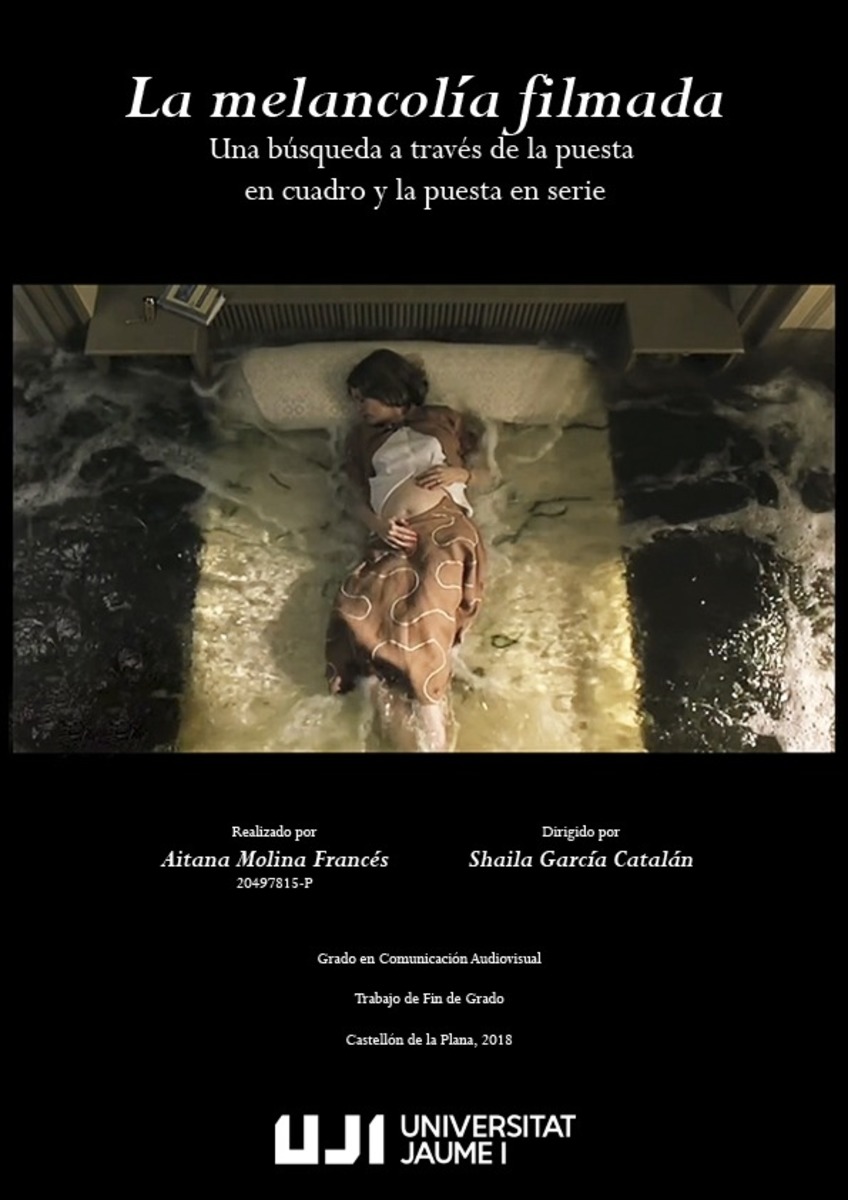Mostrar el registro sencillo del ítem
La melancolía filmada. Una búsqueda a través de la puesta en cuadro y la puesta en serie
| dc.contributor.author | Molina Francés, Aitana | |
| dc.contributor.other | Garcia Catalan, Shaila | |
| dc.contributor.other | Universitat Jaume I. Departament de Ciències de la Comunicació | |
| dc.date.accessioned | 2018-09-18T17:39:45Z | |
| dc.date.available | 2018-09-18T17:39:45Z | |
| dc.date.issued | 2018-06-05 | |
| dc.identifier.uri | http://hdl.handle.net/10234/176136 | |
| dc.description | Treball Final de Grau en Comunicació Audiovisual. Codi: CA0932. Curs acadèmic: 2017-2018 | ca_CA |
| dc.description.abstract | Durante toda la tradición artística el carácter melancólico ha inspirado un gran número de obras y ha formado parte de la personalidad de grandes artistas, viéndose reflejada en sus producciones. Son notables las referencias a la melancolía en literatura y arte pictórico, sin embargo, en el cine aún no son tan reconocibles. Así, esta investigación persigue recoger un muestrario de rasgos que evoquen o se refieran a ella. Es fácil identificar una historia o la personalidad de un personaje que evoque este temperamento, pero este texto trabaja, en mayor parte, a través de elementos de la puesta en cuadro y la puesta en serie. Resulta importante conocer, en primer lugar, qué conlleva el concepto de melancolía: estado de ánimo doloroso, desinterés por el mundo exterior, pérdida de la capacidad de amar, reproches y acusaciones a uno mismo, disminución del amor propio, tendencia al suicidio (Freud, 1992: 242)... Asimismo, también es relevante relacionar esto con la obra artística. En la literatura se muestra, sobre todo, a través de símbolos. En la pintura, la postura postrada de las figuras en el cuadro, la mirada perdida de los mismos o su decadencia son algunos de sus reflejos. Después, con la selección de las películas (La habitación verde, François Truffaut, 1978; Las horas, Stephen Daldry, 2002; Sylvia, Christine Jeffs, 2003 y Solo el fin del mundo, Xavier Dolan, 2016) se realiza el análisis fílmico. Este prioriza la búsqueda de elementos que puedan identificarse con lo expuesto anteriormente, primero de manera individual. Posteriormente, se utilizan los mismos de manera colectiva para establecer puntos y rasgos en común. Es interesante también servirse de elementos de otros ámbitos artísticos para enriquecer la investigación. Todo lo anterior conlleva, efectivamente, a características y resultados en común: montaje paralelo o alternado, símbolos referentes a un duelo irrealizado o a la distancia entre melancólicos y mundo exterior o la música como instrumento reforzador son algunos de los detallados en esta investigación. | ca_CA |
| dc.description.abstract | In the art, especially in the twentieth century, the melancholic nature has inspired a strong creation of art pieces and has been part of the personality of great artists. This has been reflected in their productions. The references to the melancholy in the literature and the pictorial art are remarkable, however, this research intends to reach a compilation of characteristics that evoke or refer to the melancholy in cinema. It is easy to identify a history or the personality of a character that evokes this temperament, but this text works, for the most part, through elements of the shot composition and the editing and mounting. It is important to know, first, what means the concept of melancholy: a profoundly painful dejection, cessation of interest in the outside world, loss of the capacity to love, and a lowering of the self-regarding feelings to a degree that finds utterance in self-reproaches and self-revilings, the tendency to suicide... (Freud, 1992, 242) Is significant also relating this to the artistic work. In the literature it is shown, especially, through symbols. In the painting, the bedridden posture of the figures in the picture, their blank stare or their decadence are some of her reflections. After this, with the movies selections (The Green Room, François Truffaut, 1978; The Hours, Stephen Daldry, 2002; Sylvia, Christine Jeffs, 2003 and It's Only the End of the World, Xavier Dolan, 2016), its is made the film analysis. First, the priority is the research of elements that can be identified with the points cited above in an individual way. Subsequently, it is required to establish common elements and points of reference. It is interesting also to use the traits of other artistic fields to strenghten the research. All this involves, effectively, to common features and results: alternate or parallel mounting, symbols that mean a never made mourning, the distance between melancholics and the outside world or the music as a enhancer element. These are some of the elements more thorough hereunder. | ca_CA |
| dc.format.extent | 63 p. | ca_CA |
| dc.format.mimetype | application/pdf | ca_CA |
| dc.language.iso | spa | ca_CA |
| dc.publisher | Universitat Jaume I | ca_CA |
| dc.rights | Attribution-NonCommercial-NoDerivatives 4.0 Internacional | * |
| dc.rights.uri | http://creativecommons.org/licenses/by-nc-nd/4.0/ | * |
| dc.subject | Grau en Comunicació Audiovisual | ca_CA |
| dc.subject | Grado en Comunicación Audiovisual | ca_CA |
| dc.subject | Bachelor's Degree in Audiovisual Communication | ca_CA |
| dc.subject | análisis fílmico | ca_CA |
| dc.subject | cine y melancolía | ca_CA |
| dc.subject | melancolía | ca_CA |
| dc.title | La melancolía filmada. Una búsqueda a través de la puesta en cuadro y la puesta en serie | ca_CA |
| dc.type | info:eu-repo/semantics/bachelorThesis | ca_CA |
| dc.educationLevel | Estudios de Grado | ca_CA |
| dc.rights.accessRights | info:eu-repo/semantics/openAccess | ca_CA |
Ficheros en el ítem
Este ítem aparece en la(s) siguiente(s) colección(ones)
-
Grau en Comunicació Audiovisual [407]
CA0932








